
The major product of the following reactions:
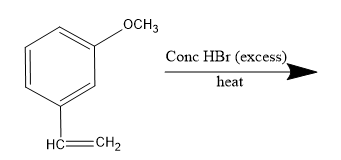
(A)
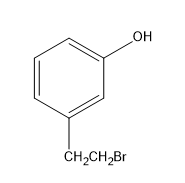
(B)
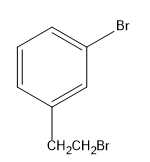
(C)
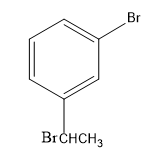
(D)
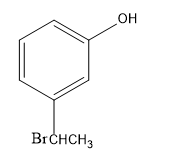





Answer
471.6k+ views
Hint: In the presence of the protic acid (HBr), the hydrohalogenation reaction will occur, through the electrophilic addition reaction mechanism. This leads to the protonation of the alkene.
Complete step by step answer:
The given compound is 3-methoxy ethenylbenzene or m-methoxy styrene which on reaction with concentrated hydrogen bromide, undergoes electrophilic addition reaction following Markovnikov's rule. Thus, it is an hydrohalogenation reaction of the unsymmetrical alkene.
-Form the Markovnikov’s rule the addition of the hydrogen bromide to the alkene is such that the proton gets added to the carbon with more hydrogen substituents and the bromide ion gets attached to the carbon with more alkyl substituents.
-So, in the reaction, the ${{H}^{+}}$ from the hydrogen bromide acts as an electrophile and is attached to the terminal carbon with more hydrogen substituents. This is followed by the formation of carbocation on the carbon with more alkyl substituent. As the benzyl carbocation formed is more stable than the alkyl carbocation.
-Then, the bromide gets attached to the carbocation, forming bromo-substituted alkane, that is, m-(1-bromoethyl) anisole.
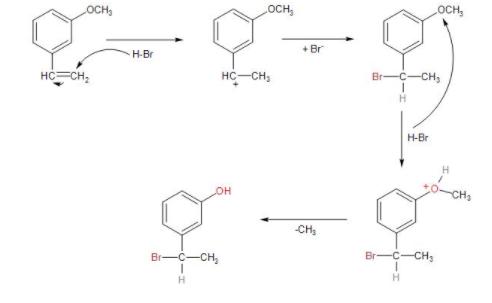
As the protic acid is present in excess, it causes further reaction to occur with the methoxy group. As the proton as electrophile attacks the oxygen atom of the methoxy group, the methyl group being a better leaving group departs. Thus, forming m-(1-bromoethyl) phenol.
Therefore, the major product of the given reaction is option (D) m-(1-bromoethyl) phenol.
Note: The Markovnikov’s rule is applied here due to the absence of the benzoyl peroxide, otherwise the Anti-Markovnikov’s rule would have been applicable.
In Markovnikov's rule, the proton in the protic acid acts as the electrophile and the stability of the carbocation formed is given preference.
Complete step by step answer:
The given compound is 3-methoxy ethenylbenzene or m-methoxy styrene which on reaction with concentrated hydrogen bromide, undergoes electrophilic addition reaction following Markovnikov's rule. Thus, it is an hydrohalogenation reaction of the unsymmetrical alkene.
-Form the Markovnikov’s rule the addition of the hydrogen bromide to the alkene is such that the proton gets added to the carbon with more hydrogen substituents and the bromide ion gets attached to the carbon with more alkyl substituents.
-So, in the reaction, the ${{H}^{+}}$ from the hydrogen bromide acts as an electrophile and is attached to the terminal carbon with more hydrogen substituents. This is followed by the formation of carbocation on the carbon with more alkyl substituent. As the benzyl carbocation formed is more stable than the alkyl carbocation.
-Then, the bromide gets attached to the carbocation, forming bromo-substituted alkane, that is, m-(1-bromoethyl) anisole.

As the protic acid is present in excess, it causes further reaction to occur with the methoxy group. As the proton as electrophile attacks the oxygen atom of the methoxy group, the methyl group being a better leaving group departs. Thus, forming m-(1-bromoethyl) phenol.
Therefore, the major product of the given reaction is option (D) m-(1-bromoethyl) phenol.
Note: The Markovnikov’s rule is applied here due to the absence of the benzoyl peroxide, otherwise the Anti-Markovnikov’s rule would have been applicable.
In Markovnikov's rule, the proton in the protic acid acts as the electrophile and the stability of the carbocation formed is given preference.
Recently Updated Pages
Master Class 12 Economics: Engaging Questions & Answers for Success

Master Class 12 Maths: Engaging Questions & Answers for Success

Master Class 12 Biology: Engaging Questions & Answers for Success

Master Class 12 Physics: Engaging Questions & Answers for Success

Master Class 12 Business Studies: Engaging Questions & Answers for Success

Master Class 12 English: Engaging Questions & Answers for Success

Trending doubts
Who is Mukesh What is his dream Why does it look like class 12 english CBSE

Who was RajKumar Shukla Why did he come to Lucknow class 12 english CBSE

The word Maasai is derived from the word Maa Maasai class 12 social science CBSE

What is the Full Form of PVC, PET, HDPE, LDPE, PP and PS ?

Which country did Danny Casey play for class 12 english CBSE

Differentiate between insitu conservation and exsitu class 12 biology CBSE




